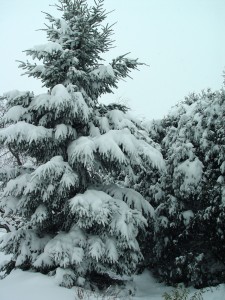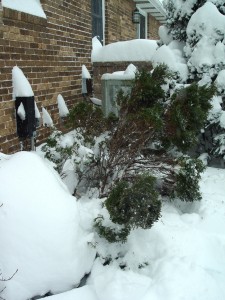Ice, Ice Baby
February 1st, 2011
Well, I’m back from summery South Africa and shell-shocked (but not surprised) at this mixed mess of wintry weather that threatens to flatten our landscapes.

Don't worry too much... most landscape plants bounce back surprisingly well from snow and ice loads.
Ice poses a particular problem for woody plants because it adds a lot of weight to already frozen, brittle branches. Given a half-inch or so coating, that’s enough to snap at least some of the weaker-wooded species (‘Bradford’ pears, white pines, Leyland cypress, arborvitae… you know who I’m talking about).
Unfortunately, there’s not a lot we can do – practically, at least – when nature decides to dump winter on us.
It’s possible to protect selected shrubs by tightly wrapping them in burlap “straitjackets” or by building small wooden lean-to’s over foundation plants that are in the way of ice and snow sliding off roofs. But you can’t go out and cover the whole landscape.
Some of you might be tempted to try and whack snow and ice off the shrubs with a broom. Be careful if you try that! There’s a good chance you’ll break branches with your whack-actions. Ice that’s frozen onto wood isn’t coming off easily. Also forget blow torches.
If you attempt anything, at least do it gently and with an upward motion that’s least likely to break branches. Don’t fall down and break a hip on the way out there either.
Personally, I’m not taking any protective or corrective action – at least not yet. I’m always impressed at how well most woody plants bounce back from snow- and ice-sagging.
Last year, a line of seven boxwoods I’ve got planted out front looked horrible after getting dumped on by the heavy snow and ice. They looked deformed forever. I tried clearing snow and despite being pretty darned careful, snapped off one fairly large branch. I quickly quit. Come spring, the boxwoods pulled themselves together and ended up looking just fine – like nothing horrendous had even happened in February. So I’m laying low this time despite the foreboding forecast.
I’ll deal with any lasting trouble at the end of winter. Broken branches will get cleanly pruned, then I’ll reshape the plants as best as I can. Any shrubs that still look like pancakes, I’ll use nylons to pull them back together and/or prune or shear them into respectability. Even if they don’t look as good as new right away, a year or two of growth will help.
Anything that takes a more serious shellacking? I’ll write it off as a wimp that can’t deal with a central Pennsylvania winter and replace it with something braver and tougher. The loss gives me room for something new I want to try anyway.
For more on ice damage and what you can do to minimize winter damage to trees, check out this past garden column I wrote here.
As for melting ice on sidewalks and driveways, ordinary rock salt is cheap and effective, but it’s also the choice most likely to damage lawns and plants.
The salty runoff can lead to excess sodium in nearby soil, and that can lead to browning around leaf margins that looks much like drought damage. Spring rains often leach the salt out of the root zones, but you can’t always count on that either.
Products with calcium chloride are a bit easier on plant roots, but they’re more expensive.
The plant-friendliest option is calcium magnesium acetate (CMA), a relatively new product made from dolomitic limestone and acetic acid.
Urea-containing products (made from ammonia and carbon dioxide and used primarily as fertilizer) are less likely to burn plants than rock salt but still can cause injury at high levels.
Then there’s the old-fashioned elbow-grease method of scraping ice off walks with a flat-bladed, long-handled ice scraper (which doubles nicely as a bed-edging tool, by the way).
Or focus on traction by scattering icy pavements with a gritty material such as sand, wood ashes or cinders.
If you’d rather look at something warm and nice than what’s coming down outside your window, I just posted a slide show on my trip to South Africa. Click here to see it or hit the “Photo Galleries” button along the left side.









